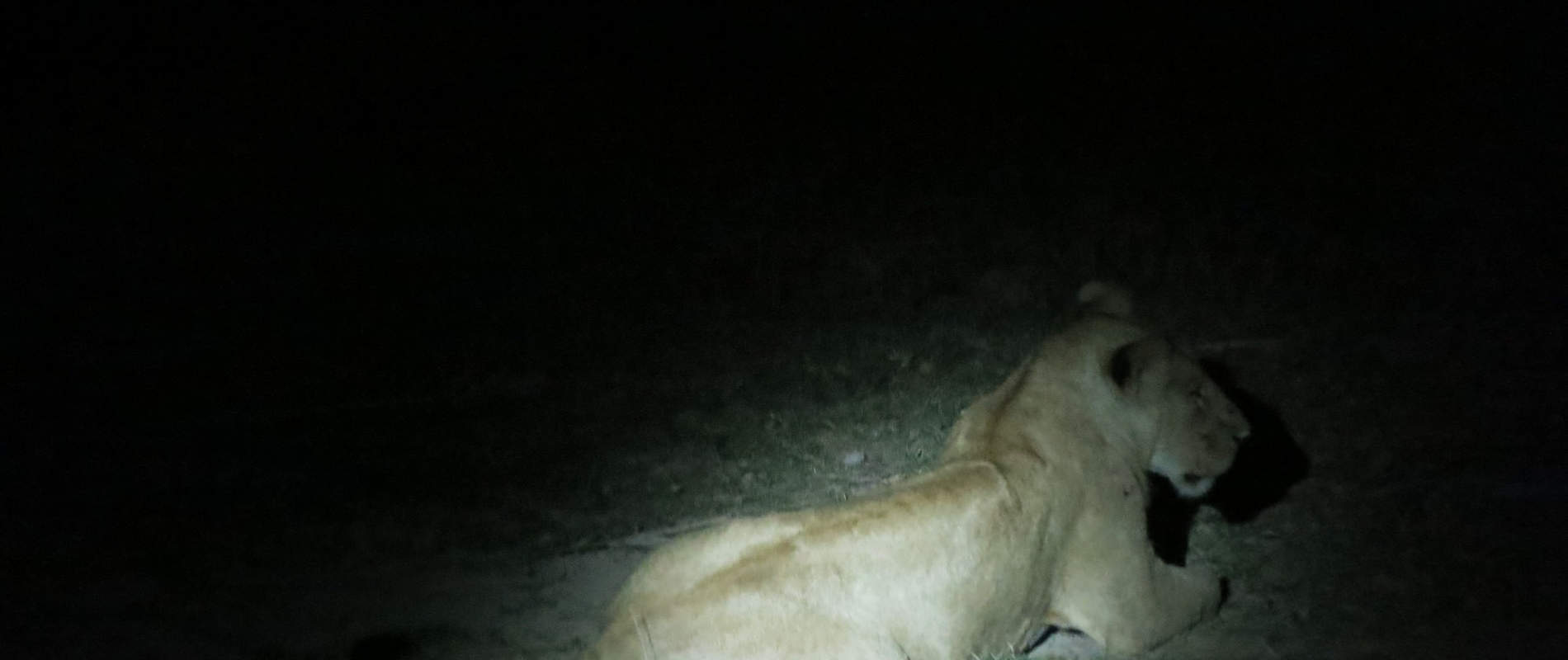FIELD VETERINARY REPORT FOR SOUTHERN CONSERVATION AREA MOBILE VETERINARY UNIT FOR THE MONTH OF FEBRUARY; 2017 Reported by Ndambiri Ephantus Introduction The Amboseli ecosystem as suffered from harsh weather conditions as the dry season continues
FIELD VETERINARY REPORT FOR SOUTHERN CONSERVATION AREA MOBILE VETERINARY UNIT FOR THE MONTH OF FEBRUARY; 2017
Reported by Ndambiri Ephantus
Introduction
The Amboseli ecosystem as suffered from harsh weather conditions as the dry season continues. As a result water pans have dried up and there is marked decrease of foliage. Animals disperse all over the ecosystem only visiting Park swamps on occasion. As animals disperse they come into conflict with humans who are competing for water and forage resources. The worst of the human-wildlife conflict cases this month were the lions poisonings.
Following are veterinary activities attended to during the month;
CASE # 1 TREATMENT OF LION
Date: 04/02/2017
Species: Lion
Sex: Male
Age: Adult
Location: Amboseli National Park
History
This lion was reported by the Amboseli Tourism Warden as being lame; walking with difficulties thus needing examination as to establish cause and if necessary, treatment. The Vet Team set out for intervention and found it along the edge of bushes near Serena Lodge.
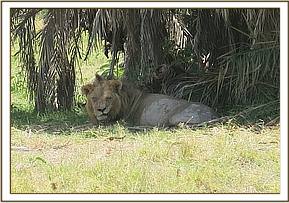

Immobilizatio, examination and treatment
The first dart constituted 325mgs Ketamine and 4mgs Medetomidine in 3cc dart but it kept shifting from one bush to another before being partly immobilized. After 25 minutes we approached and established that it was unhandlable. Another dart of 100mgs Ketamine and 1mg Medetomidine was not enough to allow manipulation after another fifteen minutes. It even appeared to be stronger than before. The third dart was prepared constituting of 250mgs Ketamine and 2.5mgs Ketamine. It was completely immobilized in the next nine minutes in right recumbence. He was blindfolded and turned on left lateral recumbence to expose the inner side of left hind limb.


The left hind limb metatarsus area was swollen and had bite wounds on the inner side of the metatarsal area. There was a one centimeter diameter raw wound possibly due to licking. Other bite marks were superficial on various body parts even at nares orifices. It had worn teeth depicting old age but had good muscle cover and seemed to have had a good meal possibly a day before. The injuries were typical of territorial fights.
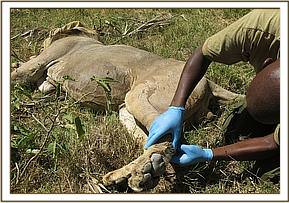

The wound was cleaned with Hydrogen Peroxide and Iodine followed by infiltration of one tube of Cloxacillin antibiotic cream. The other visible bite marks were sprayed with Tetracycline wound spray generously. Systemically it was covered with 6000mgs Amoxicillin and 20mgs Dexamethasone into different muscle sites. The three dart wounds were infiltrated with a tube of Cloxacillin cream each to counter abscess development.
Reversal and Prognosis
It was revived from narcosis after 45 minutes from the third darting with 60mgs Doxapram and 15mgs Atipamezole mixture into rump muscle. It was up on sternal recumbence in three minutes and started walking three minutes later. It was left in a shady area to recover completely on its own.


Prognosis is favourable.
CASE#2 TREATMENT OF AN ELEPHANT
Date: 5th February 2017
Species: Elephant
Sex: Male
Age: Adult
Location: Oldonyo Wuas; Chyulu Hills
History
This elephant was reported by the Big Life Foundation as having an infected wound at the base of the tail. The team immediately set out to offer medical intervention.
Immobilization, examination and treatment
The elephant was difficult to approach with a vehicle as he kept moving away into impassable bush. He was eventually approached on foot and darted with 15mgs Etorphine and 1500I.U. Hyalase in a 3cc dart. He took off and was tracked on foot and found after 25 minutes on left lateral recumbence. The right ear was used as blind fold. The trunk was kept patent by the help of a piece of stick across the rostral open end. It was dowsed with water all through the exercise to control the temperature.
At the base of the tail dorsally was an opening of about 15 centimeters full of copious creamy pus. It was possible that it had been caused by spear in either a poaching attempt or crop raiding.
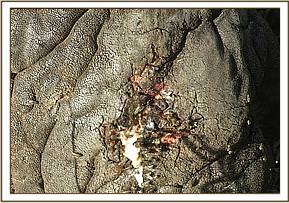

The wound was thoroughly drained of pus and cleaned with Hydrogen Peroxide and Tincture of Iodine. It was probed for any foreign body but none were found. The wound was infiltrated with three Cloxacillin cream tubes followed by green clay which was packed into the wound generously. Topically the wound was sprayed with Tetracycline wound spray to repel the flies. In addition 50mgs Dexamethasone was injected intravenously and 30000mgs Amoxicillin was injected into the muscles.
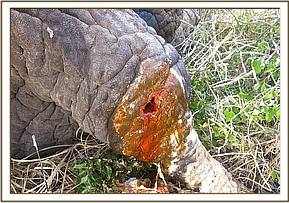

Reversal and Prognosis
Reversal was achieved by use of 60mgs Naltrexone and 24mgs Diprenorphine Hydrochlorides into the ear vein. It was completely up in two minutes and prognosis is good.
CASE#3 RESPONSE TO INJURED ELEPHANT
Date: 5th February 2017
Species: Elephant
Sex: Male
Age: Adult
Location: Kuku Ranch
Gps Coordinates: 37M 0345487 UTM 9698186
History
It was reported by the Warden of Amboseli N.P that rangers from Kimana Sanctuary and Big Life were trailing a bleeding elephant. It was established that the elephant was Tim; the notorious crop raider with a collar and that the blood was coming from an injury at the middle of its trunk. Vet services were sought so that a timely intervention could be offered.
General examination
The bull was in the company of three other bulls within Kuku Ranch in a location known to be a hot spot for poaching. They driven towards Kimana Sanctuary and intercepted for close examination. It was established that Tim had a longitudinal fresh injury less than ten centimeters seemingly inflicted by spear at the mid trunk inclined to the left side laterally. By the time of examination the injury was not bleeding and that the trunk was noted to be fully functional. The animal was energetic as it fled away from the rangers on foot and depicted no lameness. It was driven up to the eastern side of Kimana Sanctuary and left to enter the sanctuary in its own time.
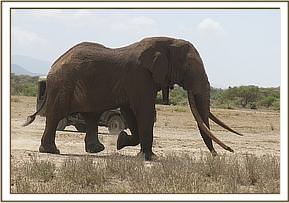

Conclusion
It was directed that the animal be monitored for any adverse signs otherwise full review would be carried out in one week if sighted. Follow-up on 11/2/2017 was futile as candidate was not located. Review will be done when the candidate resurface
Case Review
The candidate resurfaced at Amboseli Park Headquarters waterhole on 14/2/2017 when the vet team found him in company of several other males browsing. The injury to the trunk had dried and shown tremendous healing. The trunk was in full use as witnessed during drinking and browsing. Full recovery is expected in due course.
CASE#4 EUTHANASIA OF A WILDEBEEST
Date of Death: 6th February 2017
Species: Wildebeest
Sex: Female
Age: Adult
Location: Tawi lodge; Amboseli
History
This wildebeest was reported by Big Life Headquarters to have been trapped by the lodge electric perimeter fence the previous night. The Tawi security team had gotten it out of the fence after switching it off but the animal remained recumbent. We set out to intervene.
General examination
It was noted that the female was heavily pregnant. It was found on sternal recumbence with alert demeanor but with right deflected neck. It was approached by urging it to get up using a long piece of stick to probe its gluteal area but it was uncooperative. It was quickly blindfolded and held by the horns manually then put on left lateral recumbence. The vet attempted to straighten the neck but manipulation and palpation of the neck depicted sublaxated mid neck cervical vertebrae. Due to the nature of injury and to alleviate unnecessary suffering the animal was put down using 20000mgs Sodium Pentobarbitone into jugular vein.
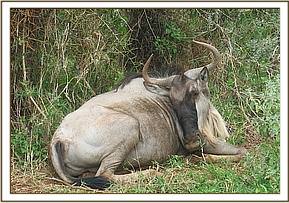

Conclusion
The struggle ensuing during repeated electric pulses resulted to irreversible neck sublaxation.
CASE#5 CAPTURE OF LEMASUSU LION
Date: 8th and 9th February 2017
Species: Lion
Sex: Male
Age: Sub-adult
Location: Lemasusu; Chyulu Hills
History
Lemasusu residents have been complaining of cattle predation by what appeared to be an elusive lion. The lion is said to raid cattle bomas constantly just at the fall of night as early as 6:30pm when cattle are getting back home. These facts were proved by the Big Life Foundation Rangers within the area and echoed by Lion Guardian Rangers.
Upon being informed KWS Rombo Station PAC Team recced the area last month and took a trap there to help capture the predator, but the lion kept on shifting strike locations making trapping difficult. The thick bushed hilly lava terrain complicates any meaningful intervention. The Amboseli Vet Unit was informed of the situation and recced the area for possible capture and translocation. First trial was done on 23rd and 24th January; 2017 after the lion killed a calf and fractured one cow’s front right limb. The trap location was within that boma which was raided. The killed calf was used as bait which was tightly secured around a tree using nylon rope and call out was made. For two nights the lion did not respond to the call and the exercise was suspended on instructions that the Lion Guardian personnel would track the lion down and identify the culpable lion considering that the area has about 16 resident lion individuals.


The exercise resumed on 8th and 9th February; 2017 when the suspected lion was seen within the perimeter of a cattle boma. Capture was planned on the evening of 8th and call outs were made at two possible suspected locations. Unfortunately no lion heeded to the calls that particular night. During the day on 9th the Lion Guardian Rangers tracked the lion down and established the new location where the suspected lion had set residence and another call out was made. in that particular area on the night of 9th the exercise was successful.
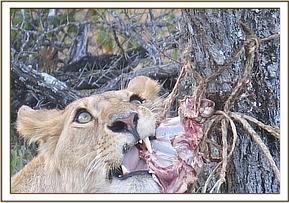

Immobilization and translocation
The lion was darted with 325mgs Ketamine and 5mgs Medetomidine after being called out of hiding to a tightly secured bait. It was in company of three other lions but the candidate had been identified positively as the notorious boma raider. He was startled after darting and retreated back into the bush. A search ensued 12 minutes after darting and the lion was located within two minutes on sternal recumbence fully immobilized. He was approached and blind folded and placed on left lateral recumbence. The other vehicles were called and the lion was quickly stretched to the waiting pick up. The relocation teams had to avoid exposure of the candidate to local residents who could turn hostile to the lion.
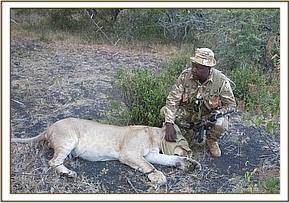

The candidate was transported to Amboseli National Park which took for two and half hours. The lion was moved without a relocation cage and the team had to monitor the anesthesia during the whole journey.
Reversal
At the release site it was noted that the animal was only under light anesthesia and so was off-loaded quietly. The anesthetic was reversed using 15mgs Atipamezole mixed with 60mgs Doxapram into the muscles. It was up in seven minutes and started roaring softly possibly seeking the presence of others. Monitoring will ensue to establish its adaptation to the new habitat.
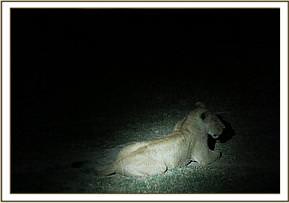

CASE#6 HUMAN WILDLIFE CONFLICT ALLEVIATION
Date: 9th February 2017
Species: Elephant
Sex: Males
Age: Adults
Location: Satao Elerai; Amboseli
Gps Coordinates: 37M 0330217 UTM 9684857
History
The Vet Unit was requested to participate in an HWC exercise involving KWS and Big Life aimed at pushing elephants across an erected fence to remove the elephants from the crop farms within the Elerai area of the Amboseli ecosystem. The exercise had to move thirteen elephants which repeatedly invaded crop farms resulting in human-wildlife conflict within the area.
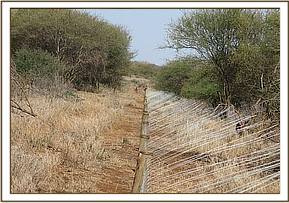

HWC Alleviation Exercise
Big Life light aircraft kept vigil during the exercise as five vehicles were deployed to drive the elephants through an open fence line. Several attempts were made but the family kept evading the open area. The second attempt saw one male cross the fence leaving 12 individuals. Another attempt was successful in driving 11 across the fence line leaving one huge bull which resisted all pushing efforts. It was eventually cornered with the help of three vehicles and forced to cross the fence by hooting and firing blanks. The exercise ended after six hours with all 13 elephants driven across the low placed fence. Monitoring will continue and it is hoped that they will keep away from the crop farm areas.
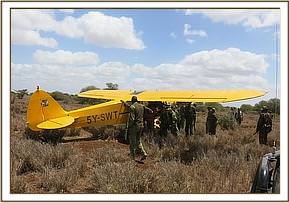

CASE#7 ZEBRA ORPHAN RESCUE
Date: 11th February 2017
Species: Zebra
Sex: Male
Age: Adults
Location: AA lodge; Amboseli
History
A call was made by Amboseli Tourism Warden regarding an injured male zebra foal less than two weeks old needing treatment at AA Lodge compound. The manager AA Lodge directed the vet Unit to where the foal was. The foal had escaped an attack by the community domestic dogs which chased it into the lodge compound where the lodge workers fended off the dogs and rescued the foal. They tethered it to a shrub by use of sisal rope
Examination and treatment
The foal was energetic with a bright demeanor. It had several bites on both the gluteal muscles and another on the left humeral area.
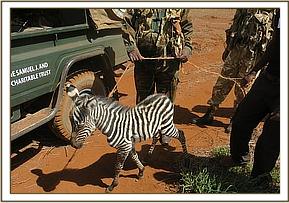

It was manually restrained in a shady area so all bites could be cleaned with Hydrogen Peroxide and Tincture of Iodine. The wounds were infiltrated with four Cloxacillin antibiotic cream tubes followed by Tetracycline wound spray which was applied generously. Systemically it was injected with 2100mgs Amoxicillin and 7mgs Dexamethasone combined into neck muscle.
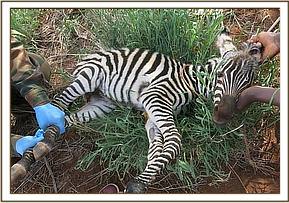

Release and Prognosis
It was released in front of a huge group of zebras grazing outside the lodge compound. One of the lactating dams immediately took an interest in the foal. Prognosis good.
CASE # 8; DESNARING OF A GIRAFFE
Date: 14th February 2017
Species: Maasai Giraffe
Sex: Male
Age: Adult
Location: Satao Elerai; Amboseli
History
The report of a snared giraffe came from SW Amboseli N.P. who had been informed by Big Life Foundation officials. The Vet Unit immediately set out to the location to intervene.
The huge male candidate had isolated itself from a large group of females who were nearby but kept a distance because of the full acacia tree being dragged by the snared giraffe which was scaring them. The winch snare wire was around the neck base rostral to the forelimbs and had caused edema. The injuries suggested the giraffe had been snared for more than four days due to the resultant skin lacerations which had begun to scab. The animal depicted signs of exhaustion but could not be approached as he was aggressive.
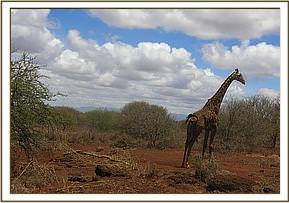

Immobilization, examination and treatment
The giraffe was approached on foot and darted with 7mgs Etorphine and 30mgs Azaperone in a 3cc dart placed in the lower neck muscles. It walked away and collapsed head first with the head twisted at an awkward angle to the body. The Vet Unit quickly corrected the head position and blindfolded the giraffe. It was held manually by the neck and the anesthetic reversed immediately with Naltrexone 80mgs into jugular vein. The wire was severed with a wire cutter and the dart recovered from the neck. It was at this juncture that we noted its muscle beginning to be flaccid and unfortunately the animal died.
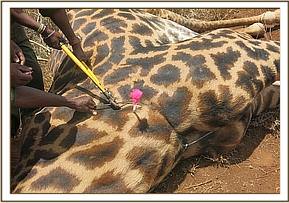

Conclusion
The twisting of the neck at the occipitoaxial joint compromised the safety of narcosis augmented by the distress caused by dragging the acacia tree for a long period of time. A de-snaring operation will ensue in the area with planned ambushes in order to nail down the perpetrators.
CASE#9 Eland death
Date reported: 14/02/2017
Date of death: 13/02/2017
Species: Eland
Sex: Male
Age: Adult
Location: Impiloni; Amboseli
History
A report was made by the Big Life Foundation regarding a dead male eland within the outskirt bushes of the crop farms. The candidate was a well-known associate of two other males who are habitual crop farm raiders within the area. The report came in while attending to the snared giraffe and we shown up to establish the cause of death.
General examination
The carcass was on left lateral recumbence. Of concern was the rate at which decomposition had set in and the carcass exhibited severe bloating. There was little degree of predation especially of the perianal area. There was no obvious physical skin discontinuity on the right side so the carcass was turned onto the right lateral recumbence to expose the left side revealing dry bloody discharge. This informed our decision to estimate the area on the carcass which was in contact with the ground. It was confirmed that there was a penetration of a sharp object to the left lumbar longismus muscle area from which the discharge was emanating caused by an arrow.
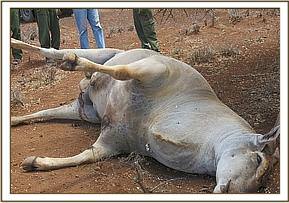
Conclusion
Tentatively the death of eland was caused by a poisoned arrow. This was informed by the rate of decomposition and blackening of less hairy parts of the skin on the carcass. The arrowing was believed to be as a result of nearby crop farm raiding secondary to ongoing drought. The carcass was disposed by burning.
CASE#10 GIRAFFE POSTMORTEM
Date of Postmortem: 20/02/2017
Species: Maasai Giraffe
Sex: Male
Age: Adult
Location: Ildilal Area bordering Tsavo West National Park
History
A local KWS Ranger/Driver who hails from the area and works at Tsavo East National Park Headquarters called the Amboseli Vet Unit concerning a recumbent giraffe near a Maasai manyatta at Ildilal Area. The animal was reported as struggling to get up.
General examination
By the time the Vet Team reached the scene the animal had already died. The carcass was on right lateral recumbence. History pre-death was that it had a severe lameness for the last two days and usually had another male companion.
Postmortem Finding
The carcass was dragged away from residential areas to a nearby bush which was a relief to the community who were complaining that the carcass would attract carnivores to the manyattas. Examination revealed the femoro-tibial joint area was severely swollen and depicted skin abrasions latero-rostrally. Dissection into the area depicted a crushed tibia head with three main bony fragments accompanied by massive clotting. The crushing force and friction of swinging leg lameness of the bone fragments resulted in bony particles of varying sizes sandwiched in the clotted blood.
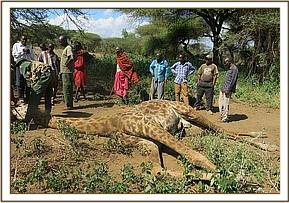

Conclusion
The compound fracture witnessed was believed to have been caused by heavy blunt object trauma onto the synovial joint area resulting into total disfunction of the joint. This could have been caused most likely by a speeding vehicle. The protracted period of severe pain (for more than two days as confirmed by community as having observed the lameness) coupled with bleeding contributed to recumbence, shock and eventual death of the subject.
CASE#11 EXAMINATIONS OF ELEPHANT CARCASSES
Date Reported: 20th February 2017
Date Examined: 21st February 2017
Species: Elephant X 4
Sex: Unknown
Age: Sub adult and Adults
Location: Tsavo West National Park
History
The report of four elephant carcasses was made by SW Tsavo West N.P following the elephant census within the conservation area. The vet was required to examine the carcasses and give a tentative cause of death.
General examination
It was observed that all four carcasses were at different locations within the conservation area. In comparison first carcass candidate was the youngest being aged as sub adult while the oldest was the fourth carcass being aged as an aged adult and presumably a big tusker. It was difficult to sex the first and second carcass whereas the third was tentatively a female. The youngest carcass was about three weeks old (first carcass) with the oldest approximated to be about one and half month to two months old (third carcass). All had undergone massive decomposition, putrefaction and dismembering. Of all, the fourth carcass was almost completely gone probably due to the large population of predators within the region.


It was noted that first carcass was on right lateral recumbence, second carcass on left lateral recumbence while the third was on sternal recumbence. It was not possible to determine the forth carcass recumbence.
It was established that only the first carcass had been documented by the park security team. It was found on the 2/2/2017 with trophies which were collected for safe custody. The third and fourth carcasses’ trophies were within the vicinity of the body and were collected for safe custody. The second carcass’ trophies were missing.
It was observed that only the second carcass death scene indicated obvious evidence of human involvement. The carcass had been covered with scarce dry bushes which had been cut from nearby bushes to conceal the carcass from being seen from the air. Within the same location there was a piece of debarked wood less than a meter long which appeared to have been intended to be used as an axe handle or something of that nature. Its skull was intact and had no signs of hacking.
According to the Park security team the tentative cause of death of three carcasses was given as natural death except second carcass which was indicated as poaching.
Conclusion
The trend within the conservation area has indicated that most of these animals are targets of arrows. The trick has been noted to be deployed by the poachers who use poisoned arrows and eventually trail down the arrowed candidates to their death locations from where they retrieve the trophies.
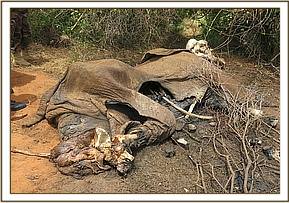

The above has led to assumption that all carcasses were targets of ill deadly practice with only the second carcass being successfully trailed down to its death scene. This is affirmed to by the fact that there was obvious indications of human activities at the scene and that there was no brutal hacking of the skull in order to retrieve the trophies meaning by the time the carcass was successfully trailed and located by poachers it was already rotten hence trophies were pulled from their sockets.
The above sightings were made possible by the fixed wing which was engaged in an elephant census. It is worth noting that with frequent aerial recces and or patrols prompt sightings can ensure that poachers don’t get a chance to lay their hands on jumbo trophies.
CASE#12 TREATMENT OF AN ELEPHANT
Date: 21st February 2017
Species: Elephant
Sex: Male
Age: Adult
Location: Tsavo West National Park
History
The Vet Unit discovered this injured elephant on route to examine the dead elephant carcasses. It had a necrotic tissue hanging just rostral to the prepuce. This injury seemed to be old and was presumed to have been due to a penetrant like a stump or arrow. The animal was ambulating strongly without any sign of lameness despite the injury. An intervention to treat it ensued immediately.
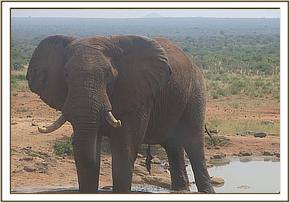
Immobilization, examination and treatment
The elephant was immobilized with 10mgs Etorphine in combination with 3000I.U. Hyalase from a vehicle. The dart landed in the right gluteal muscles prompting a quick retreat into nearby bush despite the vehicle block. A protracted search ensued on foot. It was found lying on sternal recumbence grunting heavily.
The team tried to push it onto left lateral recumbence but the strong thickets prevented this. The team then attempted to spread out the right hind limb but this was also in vain The recumbence did not allow for safe anesthesia and meaningful examination and treatment was not possible without risking the elephant’s life.
Reversal and Prognosis
The elephant was revived after five minutes of unsuccessful manipulation in order to counter poor anesthetic state. This was achieved by use of 100mgs Naltrexone into ear vein. The animal recovered quickly and was up in two minutes and walked away. Another treatment attempt can be tried after 48 hours to allow complete metabolism of the revival drugs and with aerial support in order to minimize risks of challenging terrain. Prognosis is guarded which can be revised after successful treatment intervention.
CASE#13 POISONED LIONS
Date: 23rd February 2017
Species: Lion
Sex: Male and Female
Age: Adults
Location: Osewan; Lengesim
History
The report of the dead lions was conveyed to the vet by the Amboseli Investigation team. Immediately the Vet Unit set out to determine the cause of deaths.
General examination
It was observed that the two carcasses were about 200 meters apart. It was established that there was a carcass of a head of cattle about 100 meters from the lion carcass. The cattle carcass was just a remnant of rib cage, neck and head skeleton with a small piece of skin attached to the caudal aspect of rib cage. The initial location of the cattle carcass was about 15meters away, depicted by dry intestinal and stomach contents with a few shreds of offals and a big population of dead flies, and had presumably ben dragged by other scavengers.
The carcasses were believed to be between 3- 7 days old. The lions’ carcasses were heavily putrefied and infested with maggots and a swarm of flies. Little fluid was flowing from them and the hair had greatly sloughed off and been blown away by the wind. The lion carcass was on right lateral recumbence while the lioness was on left lateral anteriorly and had spewed hind limbs. The cattle remnant was shriveled with very little wet tendons and or ligaments. Lions’ carcasses had very minimal scavenger activities especially at rectum.
There were two human foot prints leading to where the original cattle remnant was, then heading to and stopping at the current location of the carcass and then changing direction in longer strides meaning they ran away after they heard Big Life rangers searching the area.
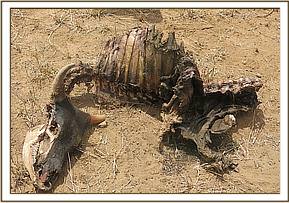

Conclusion
The activities carried out indicated human malicious involvement and it is assumed to be a poisoning incident. It is likely the cattle used as bait was lost in the bush and was attacked by the lions. Villagers upon discovering the cattle carcass decided to use it as bait. It was difficult to establish the poison used to lace the carcass due to status of the charred autolysed remains.
A massive operation to track down the culprits was instituted immediately by use of tracker dogs, KWS personnel together with Big Life Foundation Rangers, Community scouts, Lion Guardians and well-wishers. A thorough search around the scene was recommended so as to establish the carnivores and or scavengers/raptors affected by the incidence.
All carcasses were disposed of by complete wood burning to ash.
The Community was encouraged to make any report warranting intervention to the authorities. The last time such a report was made was last December and two identified lions were captured and translocated from the same area.
CASE#14 RESPONSE TO WOUNDED ELEPHANT REPORT
Date: 24th February 2017
Species: Elephant
Sex: Male
Age: Adult
Location: Oldonyo Wuas; Chyulu Hills
History
The report of a wounded elephant was made by Amboseli Park Investigation Team. It was said to be at Oldonyo Wuas waterhole and thus a quick response was necessary before it vanished into the nearby thickets. It was established that the bull had previously been treated for the same injury at least twice with the last being a year ago.
General examination
The bull was in company of another at the waterhole where they were drinking. It was observed that the anterior preputual opening had a wound which appeared to be extending posteriorly onto the ventral inguinal fold. The wound was dry with black and reddish areas of scab formation. In comparison with the accompanying bull there was no noticeable swelling of the perineal area. Few flies were seen on the forming scabs and the bull was in good body condition and ambulation was normal.
Conclusion
Earlier the wound was thought to be cancerous-like and the same assumption remains. The area security team was instructed to continue monitoring the bull because the wound condition didn’t warrant narcosis intervention. The rangers were however drilled to report if they observe any copious bleeding and or pus, any unprecedented swelling making ambulation compromised and/or inability due to emaciation or severe body loss. This was possible as the bull is a common resident of the area.
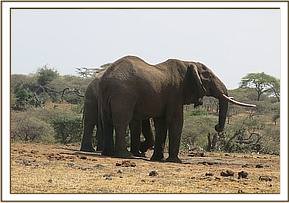

Any arising chance to treat it in near future will necessitate sampling to give way for definitive diagnosis.
CASE#15 ELEPHANT DEATH
Date reported: 26th February 2017
Species: Elephant
Sex: Female
Age: Adult
Location: Ngong Narok; Amboseli
History
The report came from PAC Team of Amboseli National Park regarding a dead female elephant at the park-community border. The Unit went to establish the tentative cause of death.
General examination
The carcass was on right lateral recumbence. The soil near the foot extremities had disturbance marks indicating the animal struggled before death. The carcass was approximated as less than twelve hours old but the tentative age of the elephant was above thirty years as indicated by its’ worn out molars. It had its’ trophies intact.
The body condition was poor as depicted by bony prominences especially the facial crest and the spine. The keratin layer of skin at some points had sloughed off showing activities of the rest of family member trying to urge the candidate to move or get up. Other areas where the keratin skin layer was still hardly attached was because of direct sun meaning the elephant died early morning several hours earlier before being sighted in the evening.
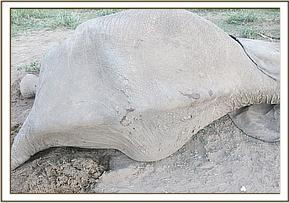
Examination after flipping on the other side revealed no obvious external injury or skin break. There were no unusual discharges from any orifice.
Trophies were retrieved and handed to Park Security Team for safe custody and onward transmission.
Conclusion
Tentatively cause of death is assumed to be natural which could have been augmented by poor dentition and prevailing shrubbery scarcity.
CASE#16 ELEPHANT TREATMENT
Date: 28th February 2017
Species: Elephant
Sex: Male
Age: Adult
Location: Ziwani ; Tsavo West National Park
History
This elephant was reported by Kaluku Operation Room after it was spotted in the morning by DSWT air patrol within the park. The vet from Southern Conservancy Area Mobile Veterinary Unit was picked via DSWT fixed wing and dropped at the Ziwani Voyager airstrip where he joined the DSWT de-snaring team from Maktau Gate. The Teams spent hours trying to relocate the elephant and eventually the fixed wing was called again to help but all was in vain. The Amboseli vet Mobile Unit vehicle was coming to pick the vet after intervention but joined the search. Fortunately the family of 13 was eventually located under thick bushes and intervention ensued. The fixed wing was alerted and it left for Kaluku because fuel was low while the Maktau Team had already left to fuel at Voi.
Immobilization, examination and treatment
The elephant was sedated while on a chase using 10mgs Etorphine and 3000 I.U Hyalase in 1.5cc dart after separating it from the rest of family members. It was maintained on in a relatively open location by use of a vehicle for eight minutes post darting until it was fully narcotized on right lateral recumbence. The left ear was used as blind fold. The trunk was kept patent by the help of a piece of stick across the rostral open end.


The hernia-like swelling on the left belly region had a raw wound about 15cm in diameter with creamy gray pus around the edges. It was soft on palpation and appeared to be just within the dermis. Any aspiration attempt yielded no exudate and there was no bleeding from the aspiration fenestrae. It appeared to have been there for a long period as edges were granulating and epithelializing indicating wound healing. It was suspected to have been as a result of constant friction on the surface of the abdominal hernia as the animal rubbed itself against objects in the bush. It didn’t appear to be tumorous because there was no bleeding as expected with tumors even after the scab was rubbed off.
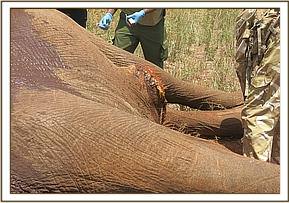

The wound edges were freshened and cleaned thoroughly with Hydrogen Peroxide and Tincture of Iodine. Swabs were used to sponge the wound dry after which 20mgs Ivermectin was topically applied to discourage maggot infestation. Then the wound was gently covered with wet green clay followed with generous Tetracycline wound spray. It was covered with 50mgs Dexamethasone intravenously, and 30000mgs Afloxacin and 100ml Multivitamin intramuscularly. This treatment took eleven minutes.
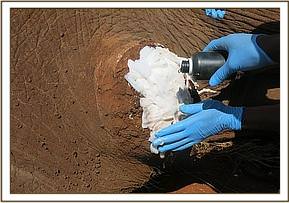

Reversal and Prognosis
The anesthetic was reversed using 80mg of Naltrexone via the ear vein. It was completely up in three minutes.


A review will be carried out after a month if sighted but so far the prognosis is favourable.
Acknowledgement
The Southern Conservation Area Mobile Vet Unit wishes to express heart felt gratitude to the KWS fraternity together with the David Sheldrick Wildlife Trust through their amicable engagement that has seen the above interventions being realized within the affordable time possible. Other key aiders who cannot be forgotten are the ever friendly community, the private Conservancies and the Conservation NGOs like Big Life Foundation and Lion Guardian amongst many within the Amboseli ecosystem
